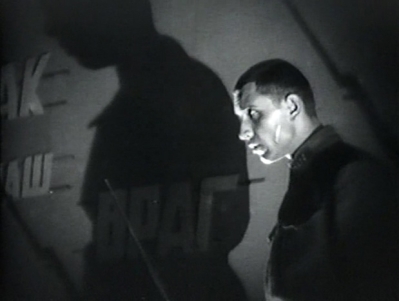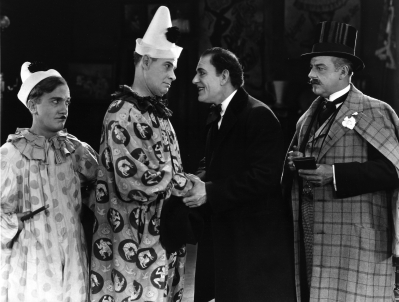A popular adage among people in recovery warns that "the definition of madness is repeating the same behavior over and over again while hoping to get different results." The real issue at hand is whether or not anyone makes a serious effort to learn from their mistakes.
Two films screened during this summer's San Francisco Silent Film Festival had a powerful dramatic impact on the audience. Directed by Michael Kalatozov (The Cranes Are Flying, I Am Cuba), 1931's The Nail in the Boot may lure modern audiences into thinking of it as an anti-war film. But what The Nail in the Boot really tackles is the issue of compromised standards in a critical manufacturing chain of supplies.
Originally intended as a military propaganda film, The Nail in the Boot's basic message is that sloppy workers are capable of sabotaging a country's national defense (the film's alternative title was The Homeland Is In Danger). Where have similar issues appeared in the news?
- In 1997, impact tests conducted at the University of Missouri-Rolla that were performed on pieces of steel retrieved from the wreck of the R.M.S. Titanic revealed that, when tested at the estimated temperature of the water when the ship struck an iceberg on April 14, 1912, the hull's steel plates were nearly 10 times more brittle than modern steel. The chemical composition of the steel showed a high content of sulfur, oxygen, and phosphorus combined with a low level of manganese (all of which can cause steel to be more brittle).
- In the past 20 years, children's toys containing traces of lead and numerous other products made in China have proven to be made with substandard and often toxic ingredients.
- Throughout the wars in Iraq and Afghanistan, American troops have struggled with inadequate body armor that was either poorly designed or made with substandard materials (that allowed a military contractor to turn a larger profit).
As seen in a beautifully restored print from the Georgian National Film Center, Kalatozov's 54-minute movie begins on the battlefield as a soldier is sent to notify headquarters that the troops trapped on an armored train urgently need backup in order to avoid annihilation. Because a nail sticking out of the sole of his boot causes the soldier increasing pain, he fails to deliver the crucial message on time.

An armored train built in Slovakia that was used in World War II
Photo courtesy of Wikipedia
The scene in which the train is destroyed is a breathtaking piece of drama. However, what follows is equally impressive. During a courtroom investigation, the soldier pins the blame squarely where it belongs: on the workers whose sloppiness contributed to his delay.
In the past several years, Stephen Horne has accompanied many screenings at the San Francisco Silent Film Festival in which his playing has been strongly influenced by the music of Maurice Ravel and Claude Debussy. The screening of The Nail in the Boot gave Horne a chance to show a very different side of his skills as an accompanist. Reaching for the heavy artillery in his musical tool bag, he performed the kind of octave-pounding endurance test that could make Sergei Rachmaninoff nervous.

A scene from The Nail in the Boot
Although the filmmaker's mentor, Lev Kuleshov, claimed that "Kalatozov could shoot anything and make it interesting," Stalin's censors were less impressed. They prevented Kalatozov from making any movies during the eight years that followed The Nail in the Boot, claiming that the filmmaker had failed to depict the ideology they wanted to see in what was essentially an agitprop film. The censors required Kalatozov to undergo a period of "forced rehabilitation" during which he was not allowed to direct any of his own projects.
While The Nail in the Boot may not have been appreciated by Russian censors, it stands today as a magnificent and unassailable piece of cinematic art. There's something to be said for that.
* * * * * * * * * *
The first film to be produced by Metro-Goldwyn-Mayer (following the merger of Metro Pictures, Goldwyn Pictures Corporation, and Louis B. Mayer Pictures), Victor Sjöström's 1924 triumph, He Who Gets Slapped, was the closing night presentation at this year's San Francisco Silent Film Festival. Accompanied by the Matti Bye Ensemble, its screening was a huge success that ended the festival on a high note.
Adapted from a 1914 play by Leonid Andreyev, the film stars Lon Chaney as Paul Beaumont, a scientist who, in one horrible day, gets cheated out of the fruits of his research and the love of his wife (Ruth King) by his wealthy patron, Baron Regnard (Marc McDermott). If that weren't humiliating enough, the Baron cruelly slaps Beaumont across the face in front of his scientific peers.
Beaumont subsequently suffers a nervous breakdown. Five years later, he has become a popular circus clown known for his bizarrely masochistic specialty act. Known only as "HE," the audience wildly cheers his ongoing humiliation each time one of the other clowns slaps him in the face.
Ever the unlucky lover, HE has fallen for the charms of Consuelo, (Norma Shearer) a beautiful young woman who has recently joined the circus. Unaware that she is smitten with one of the troupe's star equestrians, the handsome Bezano (John Gilbert), HE risks everything by opening up his heart and confessing his love to Consuelo. True to form, she slaps his face and laughs at his earnestness.
Quickly covering his emotions, HE stresses that whenever he gets serious he is merely joking. But when HE learns that Consuelo's greedy father, Count Mancini (Tully Marshall), is hoping to marry her off to a rich suitor in order to restore the family's lost fortune, he is justifiably concerned. His compassion, however, turns to horror upon learning that the potential suitor is none other than his arch nemesis, Baron Regnard.

Tricaud (Ford Sterling) and HE (Lon Chaney) are two circus clowns
in 1924's He Who Gets Slapped
What follows is a brilliant buildup of suspense as HE decides to exact his revenge on the Baron and the Count (with the help of some hungry circus lions) so that Consuelo and Bezano are free to fall in love. With a magnificent new score composed by Matti Bye and Kristian Holmgren (a co-commission by the San Francisco Silent Film Festival and the Headlands Center for the Arts), He Who Gets Slapped reached the kind of intense climax one rarely finds outside of silent film.
I say this because, back in the silent era, stars like Lon Chaney, Buster Keaton, and Harold Lloyd insisted on performing all of their own stunts. Norma Shearer and John Gilbert (whose careers were just beginning when they made He Who Gets Slapped) follow suit on horseback in this film. The thrills felt by the audience have a great deal to do with watching artists taking risks (as opposed to some inherently safe CGI scripting).
As a result, it's difficult to tell which was more thrilling: Chaney's bravura performance, Sjöström's meticulous and artful direction, or the music being performed live by the Matti Bye Ensemble. One thing is for sure: the restored print (Courtesy of the George Eastman House) looked a helluva lot better than this trailer from YouTube:
To read more of George Heymont go to My Cultural Landscape
